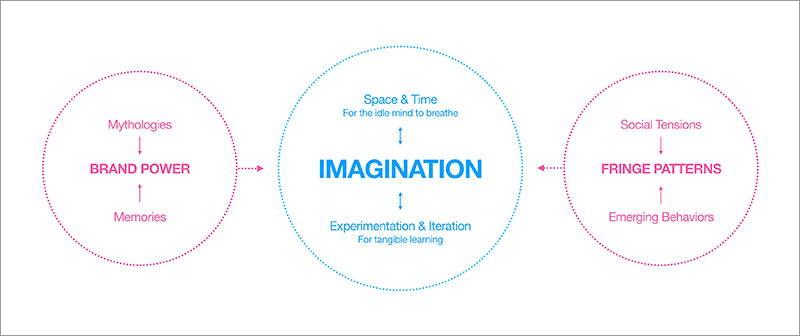What's Next for Imagination: Technology, Fiction and Brand Experimentation (Part 2)
Building off of the first part of this piece, it’s now important to explore the implications of the blurring lines of reality and fiction and the broadening definitions and roles of creativity and design.
Reality by iterative design
The field of “creative” applications to business and social challenges is evolving.
When we talk about brand design and marketing, it goes deep into the fundamentals of how businesses not only present themselves to the world but how they purposefully operate and deliver the experiences that create that world. What a brand represents (even if it’s simply a product on a shelf) is an expression of the systems used to manufacture and deliver it. For this reason, creatives and designers are increasingly welcome in the boardroom for alternative, human-centered perspectives that can augment traditional business modeling and operations. “Creative” needs to expand its scope and think bigger about how ideas manifest in the world through the brand systems. Creativity must assume the posture of design and entrepreneurship.
Design is more than how things look; it’s how they work. “Design,” derived from the French verb meaning “to designate or indicate,” is the act of orchestrating people, places and things to achieve a goal. Designers work with two primary things in mind: the “who,” the human perspective (consumer/user/customer), and the “how,” the way things are delivered through manufacturing and operations.
The creative class currently focused on advertising and mass brand-building needs to embrace a hybrid mind-set and process in order to direct the power of brands, address emerging social tensions and learn from the social and economic patterns that exist on the fringes of popular culture.
Persuasion is no longer the name of the game; it’s about building trust through relevant engagement. Product and service experiences are the marketing. We can’t just craft ideas for mass communications. We must think about how the ideas can come to life in a person’s daily routine—how we can make them come to life. Think of the creative process as hypothesis-driven experimentation.
The new hybrid creative process
We need to embrace a style of work that allows for social experimentation and development through two lenses: brand power and fringe socioeconomic patterns.
Embrace the power that brands hold on our lives
Brands are the symbolic and experiential engines that shape our reality. They represent a promise associated with products and services that define our lives, symbolizing experiences lived with those products and services. Brands also represent ideas and aspirations that we associate with a range of possibilities for our identities. Have you ever felt like “just a number” when interacting with a brand? When a passenger was violently dragged off a United Airlines flight for refusing to give up his seat on an oversold flight, who did we blame: the captain and crew, or the brand?
Imagine you’re holding two apples. In your left hand, you hold a ripe red apple, and in your right, an almost identical ripe red apple, except for one small detail: This one has a Whole Foods sticker on it. How are they different? What do you project onto the Whole Foods apple? Is it better or worse? Either way, something is qualitatively different about those apples, even if they fell from the same tree. There are two things present in your interaction with these apples: your past experiences—or lack thereof—with Whole Foods, and the presence of the brand or “system” that is Whole Foods.
Brands shape our behaviors, choices, expectations, emotions, cultures, memories and, most important, our sensibilities. We need to be aware on a qualitative and quantitative level when making decisions about the role brands play in our daily lives as well as their myth-generating potential.
Use fringe patterns to understand emerging behaviors
We need to embrace the strangeness of our current reality. Our shared anxieties and desires are expressed in new and often unexpected social behaviors. These are patterns of desired experience that live outside the norms of market validation.
In fringe patterns, we can recognize emerging social tensions as opportunities for change. We need to pay attention because shit is getting weird. Let’s start with a simple example. What do amusement parks and everyday jobs have in common? KidZania is the answer—an amusement park that lets kids live out the career experiences of adults. Is everyday life really this fascinating, or have we lost our ability to appreciate these experiences?
When it comes to daily routines, our critical and attentive faculties are inundated by Pavlovian design aesthetics, and the ethical frameworks to protect us have yet to be defined. The devices we carry with us are meant to make our lives more convenient but end up distracting us to death and fragmenting our social bonds. Do you spend more time browsing content on Netflix than you do watching it? Is the majority of your social interactions translated through a keyboard? Google has just introduced Android features that allow us to monitor the impact of pervasive mobile tech on our daily lives.
Rituals are being appropriated and harvested for commercial purposes. A few years ago, Lululemon held an event in Manhattan’s Riverside Church called The Gospel of Sweat. Brand loyalists were invited for a day of yoga, talks on wellness and other inspirational content. A space with the aura of religious tradition was repurposed for a brand’s vision of a yoga-fied spiritual community. The desire to find personal meaning is coming to life in our engagement with brands. We are trying to validate our consumer choices. Categories like travel and leisure are changing as well, with the rise of the voluntourism movement. People are searching for new purpose in old consumer conventions.
Feeling forward
If you sit back and reflect for a moment on the possibilities, everything is up for grabs! Our ability to plan for the future lives on the razor’s edge of constant disruption. Predictions and future thinking are obsessed with dystopian images rather than new forms of value. The future is rarely concerned with the fascination and joy of possibility.
We must embrace the power of brands to orient our current reality. We must examine social tensions as means of exploring new ways to hack cultures and economies in a positive way. We must investigate and leverage social and economic momentum on the fringes. And we must make some decisions about where we’re headed as a society, what ideas and experiences are critical to living, how people should purposefully engage with each other, and the role brands play in shaping our future.
Helen Keller once wrote that “life is either a daring adventure or nothing.” For those unfamiliar with her story, Keller contracted an illness as an infant that left her stricken blind and deaf. Her courage in the face of sensorial limitation should be an inspiration to all who shape their reality through engagement with the world. Keller gave us a new sensibility, transcending a world of sensory deprivation to create her own reality.
We have to create goal-oriented, immersive mashups for business, discovery and living. We need less advertising, less economic modeling, less disruption and more experimentation and play. Let’s give imagination free rein and see what happens next.







